Captain’s Blog
Friday
Yellowstone National Park
Fishing Bridge,
Fishing Bridge RV Park
July 10, 2009
We were up early this morning for our adventure out to Old Faithful. As I mentioned before getting from point A to point B is a real journey because of the winding roads, slow speed limit and wild animals in the roads, not to mention all the people in the roads trying to get a close up look at those animals.
First stop along the way was at the West Thumb Geyser Basin that overlooks Yellowstone Lake. West Thumb is a caldera within a larger caldera. A powerful volcanic explosion approximately 180,000 years ago, caused the earth’s crust to collapse creating the West Thumb Caldera. The depression later filled with water to become the largest bay of Yellowstone Lake. The West Thumb Caldera lies within one of the world’s largest caldera’s that encompasses the central and southern portions of Yellowstone Park.
Along the geyser trail we stopped at the Twin Geysers – one geyser with two vents. This geyser has short periods of dramatic eruptions and extended periods of dormancy. No luck for us – no eruption today just bubbling hot water.
The Abyss Pool is one of the deeper hot springs in the park and descends 53 feet. The colors were spectacular from a turquoise blue to emerald green with a perimeter of varying shades of brown. The steam rising from these pools makes one stop to think about the boiling caldron that exists beneath our feet.
After the 1959 Hebgen Lake earthquake, which measured 7.5 on the Richter scale the landscape changed dramatically. The Blue Pools along the trail were renamed Seismograph Pools. The pools today are not blue but muddy but not from earthquakes, but from runoff of the nearby mudpots.
The Thumb Paint pots were equally intriguing. These mudpots or “Mud Puffs’ look like miniature volcanoes 3-4 feet high with steam coming from the mud chimneys in varying shades of color from brown to red. The plop, plop, plop of the mud as it popped up maintained everyone’s attention. Some of the mud sprang high enough to fall onto the walkways.
Mudpots differ from most hot springs: their water more acidic dissolving the underground geological plumbing system into wet clay mud. Depending upon the amount of precipitation they may look like muddy water, other times so thick that they look like you could build pottery with the mud. Today the mud was really thick an plopping.
Percolating Spring bubbles vigorously like a percolating coffee pot. The pool is a beautiful blue. Surging Spring has an average temperature of 167 degrees, domes up and overflows, sending waves of water into Lake Yellowstone. Despite the fact that the geyser basin pours an average of 3,100 gallons of hot water into the lake every day the lake’s average summer temperature remains at 45 degrees.
The varying colors in the pools of West Thumb are created, in part, by heat-loving organism called, thermophiles. Green and brown indicates organisms living in cooler waters, orange and yellow those organisms living in hotter water. Only a few microorganisms thrive in the springs where temperatures are close to boiling, so in those springs the water is clear and blue. In these hot springs the water absorbs all wavelengths of color except blue that the pool reflects. The blues in the pools are so vibrant and beautiful and are accentuated by bubbling water and the white plumes of steam being emitted from the pools.
After completing our fascinating tour of West Thumb we headed to Old Faithful. Along the way we stopped to take a picture at the Continental Divide, elevation 8,391 feet. 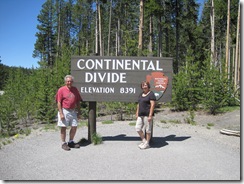
Old Faithful lies in the Upper Geyser Basin. The majority of the world’s active geysers are here. Only three other locations in the world – Iceland, New Zealand, and Kamchatka (Siberia ) – have large concentrations of Hydro thermal features. The rangers predict eruptions for five of the area geysers: Old Faithful, Castle, Daisy, Grand and Riverside.
This is a scary thought, but since Yellowstone sits in a caldera I guess it makes sense that molten rock or magma may be as close as 3-8 miles underground. The magma provides the first ingredient for thermal features – heat. Rain and snow provide the second – water. The water seeps into the ground several thousand feet where it is heated. Underground cracks and fissures form the third ingredient, a natural plumbing system. Hot water rises through the plumbing to produce hot springs and geysers.
Within the park are the mudpots, acidic hot springs with limited water supplies, hot springs, closely related to geysers and fumaroles, the hottest surface feature that vent steam. Sure is an active hot place looking to release that inner gigantic caldron – hopefully not while we are here.
We arrived at Old Faithful just in time for an eruption. She was a slow boil but when she finally did erupt 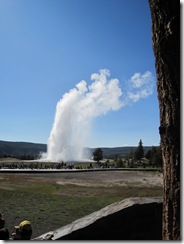 it was spectacular. Unfortunately it only lasted a couple of minutes then it was over. The rangers do a fairly good job at estimating the times of eruption – usually 90 to 120 minutes apart. Old Faithful erupts more frequently then other big geysers, although it is not the largest or most regular in the park – it is the most famous. An eruption lasts 1 ½ to 5 minutes, expels 3,700-8,400 gallons of boiling water, and reaches heights of 106-184 feet.
it was spectacular. Unfortunately it only lasted a couple of minutes then it was over. The rangers do a fairly good job at estimating the times of eruption – usually 90 to 120 minutes apart. Old Faithful erupts more frequently then other big geysers, although it is not the largest or most regular in the park – it is the most famous. An eruption lasts 1 ½ to 5 minutes, expels 3,700-8,400 gallons of boiling water, and reaches heights of 106-184 feet.
After watching the eruption we opted to have lunch. I’ve been packing a lunch every day because the prices here are ridiculous. We sat on the porch of the Old Faithful Inn and enjoyed a leisurely lunch.
Then it was off to do the four-mile hike around the Geyser Hill Basin. Although we were amazed at the thermal pools and geysers at West Thumb we were even more amazed on this hike. Not all geysers and thermal pools are alike.
The number of geysers is astounding and the first we stopped at on the trail was Anemone Geyser. It completely drains then within a few minutes it begins to fill and bubble then erupts suddenly to over six feet repeating the cycle every 7-15 minutes. Plume Geyser was even more spectacular with eruptions every hour and we were lucky to witness an eruption that was better then 25 feet in height.
Upon reaching Castle Geyser we were taken back by its size. The cone of Castle Geyser is thousands of years old and rests on older platforms. It erupts infrequently, maybe once daily so we didn’t get to see it. When it does erupt it reaches 75 feet and last about twenty minutes. 
As we passed more thermal pools with beautiful blue and turquoise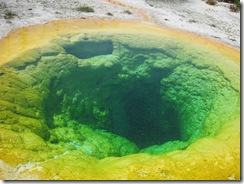 hues we appreciated even more the dynamic nature of our planet. We usually think of the Earth as Terra Firma but we are really at the mercy of its evolution.
hues we appreciated even more the dynamic nature of our planet. We usually think of the Earth as Terra Firma but we are really at the mercy of its evolution.
Crested Pool was interesting and at 199 degrees it boils constantly sometimes to levels of eight feet. While we watched we tried to imagine the heating element beneath our feet and how far below us is it really ????
The Many Geysers along the way were in various stages of boiling and erupting some more spectacular then Old Faithful. Despite all our research and understanding of the geological and thermal components of Yellowstone we were pleasantly surprised at the vast number of thermal activities taking place within the park.
Morning Glory Pool 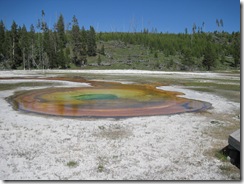 is a favored destination of Park visitors with good reason. It was named in the 1880’s for its likeness to the flower of the same name. Unfortunately the pool became victim to vandalism as over the years people have thrown tons of coins, trash, rocks and logs into the pool. What is wrong with people?????????????? The debris became embedded in the sides and vents reducing water circulation and the water temperature. Although still a beautiful blue, orange and yellow colors of bacteria that grow in cooler water dominate the Morning Glory Pool. The park Rangers clean out the pool regularly hoping to restore its water flow and former glory. I guess we’re lucky to have seen it before it fades away completely.
is a favored destination of Park visitors with good reason. It was named in the 1880’s for its likeness to the flower of the same name. Unfortunately the pool became victim to vandalism as over the years people have thrown tons of coins, trash, rocks and logs into the pool. What is wrong with people?????????????? The debris became embedded in the sides and vents reducing water circulation and the water temperature. Although still a beautiful blue, orange and yellow colors of bacteria that grow in cooler water dominate the Morning Glory Pool. The park Rangers clean out the pool regularly hoping to restore its water flow and former glory. I guess we’re lucky to have seen it before it fades away completely.
Back at the Inn we sat on the porch to watch another eruption of Old Faithful. We had a great view and the second eruption was even more spectacular then the first we had seen.
At this point it was around 6 PM so we headed back to the MH. The ride back provided many beautiful vistas and a chance to see more wild life. Buffalo are very prevalent but not in huge herds like they were in the Tetons. They are spread out across the plains and sometimes in the roads. Back at the MH we had dinner and attended another Ranger Program.
The day was beautiful and the night very cool requiring our heat pumps to keep us warm. No complaints though. After 8-10 hour days touring and hiking, a good night’s sleep in a cool room is great.
r0n NOTE: can you believe when the traffic backs up now for a Bison, I say those newbes haven't they seen a Buffalo before? Deb says it is just a Buffalo put the camera away.
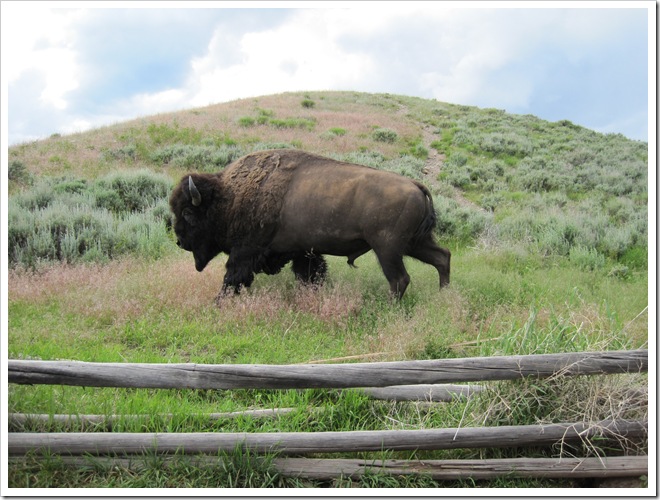
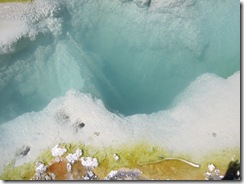
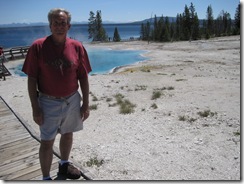

No comments:
Post a Comment